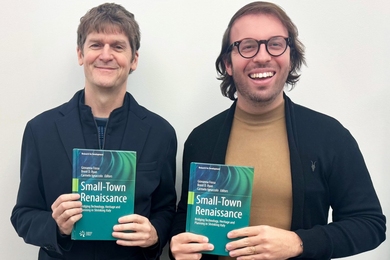Animals have complex dreams and are able to retain and recall long sequences of events while they are asleep, MIT researchers reported for the first time in the January 25 issue of the journal Neuron.
While any pet owner knows that animals seem to dream, and studies show that animals' brains follow the same series of sleeping states as ours do, this is the first time that researchers know what animals are dreaming about.
"No one knew for certain that animals dreamed the way we do, which can involve replaying events or at least components of events that occurred while we were awake," said Matthew Wilson, associate professor of brain and cognitive sciences in the Center for Learning and Memory. "We looked at the firing patterns of a collection of individual cells to determine the content of rats' dreams. We know that they are in fact dreaming and their dreams are connected to actual experiences."
Professor Wilson said this new ability to eavesdrop on the sleeping brain provides a basis for analyzing the content of dream states. It could be a valuable tool in treating memory disorders such as amnesia or Alzheimer's disease, or it may help devise ways for people to learn and memorize more effectively.
"It has been a century since Freud brought forward the study of the subconscious and the examination of the content of dreams as a tool for understanding the nature of cognition and behavior in humans," he said. "We now have the means to bring this world of dreams into the study of animal cognition, and by doing so, gain deeper insight into our own."
RUNNING IN CIRCLES
Professor Wilson and biology graduate student Kenway Louie trained rats to run along a circular track for a food reward. They monitored the animals' brain activity during the task and while they were asleep. While the animal ran, its brain created a distinctive pattern of neurons firing in the hippocampus, a brain area known to be involved in memory.
Like us, rats go through multiple stages of sleep, from slow-wave sleep to REM sleep. In humans, it is during REM sleep that most dreaming occurs.
The researchers then examined more than 40 REM episodes recorded while the rats slept. About half repeated the unique signature of brain activity that was created as the animal ran. The correlation was so close that the researchers found that as the animal dreamed, they could reconstruct where it would be in the maze if it were awake and whether the animal was dreaming of running or standing still.
These memories were replayed at about the same speed that the animal had experienced them while awake.
NOT-SO-INSTANT REPLAY
Professor Wilson explores how sleep may be involved in the formation of long-term memories. Scientists believe that memories are formed in at least two stages: an initial process that occurs during the experience itself, followed by a consolidation period in which the experience is transformed into long-term memory. The hippocampus is believed to be involved in both stages.
The long-term encoding of memories may occur when memories are reactivated during sleep. Professor Wilson's research focuses on how memories are incorporated in the brain during sleep and how reactivating memories during sleep affects long-term memory and performance.
"If you learn five things when you are awake, which ones are retained?" he said. He speculates that if certain bits of information are replayed during sleep, this might determine which events we then remember.
Studies have shown that humans learning repetitive tasks can use REM sleep to enhance performance. In some cases, this "off-line" practice session seems to be just as good as practicing the experience when awake. Tests have shown that both rats and humans are better at a recently learned task after a period of sleep.
Likewise, dreams may represent an opportunity for us to continue to work on a problem while we're asleep. Some people report waking up with a solution to a problem that had been puzzling them for days.
"One theory regarding the role of dreams in memory is that dreams may provide the opportunity to bring together experiences that were related, but did not occur at the same time, in order to learn from them," Professor Wilson said. "For example, replaying a series of pleasant or unpleasant experiences may allow us to learn what these experiences had in common and use this to guide future behavior."
ANIMAL DREAMS
Why do animals dream about one experience and not another? "This work allows us to evaluate the content of dreams and create tests to see which awake patterns create patterns when the animal is asleep," he said. "If we are able to evaluate the content of the dreaming state, we may be able to find out why certain events get replayed and others don't."
This work also raises questions about long-held assumptions about animals' thought processes. Only a handful of species -- among them chimpanzees and dolphins -- were thought to have any ability at all to recall and evaluate detailed sequences of events after they occurred. Professor Wilson noted that "dreams are the ultimate off-line experience. This work demonstrates that animals are capable of re-evaluating their experiences when they are not in the midst of them."
The Center for Learning and Memory was established in 1994 as an independent research center between the Departments of Brain andCognitive Sciences and Biology. The mission of this multidisciplinary center is to decipher the brain's molecular and cellular mechanisms and the neural circuitry underlying learning and memory and to piece the puzzle together into an understanding of the intelligent and complex functioning of the brain.
Professor Wilson's work is funded by the National Institutes of Health and the RIKEN-MIT Neuroscience Research Center.
A version of this article appeared in MIT Tech Talk on January 31, 2001.







